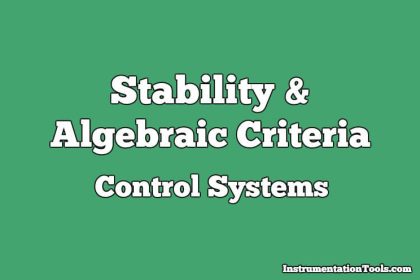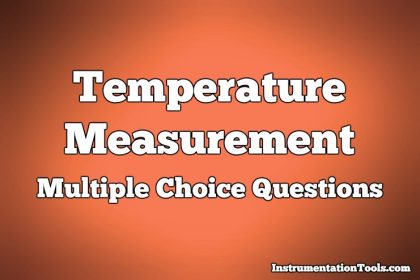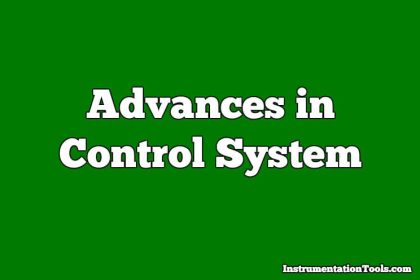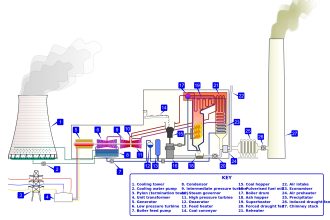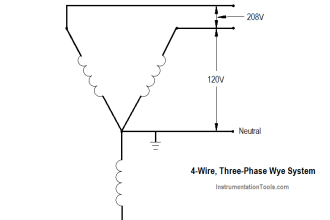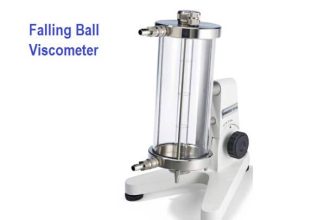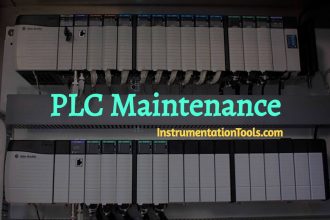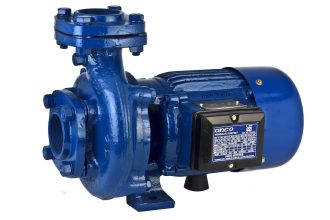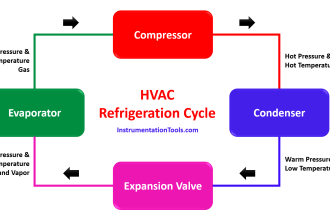Measurement and Instrumentation Objective Questions
1. The use of _____ instruments is merely confined within laboratories as standardizing instruments.
(a) absolute
(b) indicating
(c) recording
(d) integrating
(e) none of the above
Ans: a
2. Which of the following instruments indicate the instantaneous value of the electrical quantity being measured at the time at which it is being measured ?
(a) Absolute instruments
(b) Indicating instruments
(c) Recording instruments
(d) Integrating instruments
Ans: b
3. _____ instruments are those which measure the total quantity of electricity delivered in a particular time.
(a) Absolute
(b) Indicating
(c) Recording
(d) Integrating
Ans: d
4. Which of the following are integrating instruments ?
(a) Ammeters
(b) Voltmeters
(c) Wattmeters
(d) Ampere-hour and watt-hour meters
Ans: d
5. Resistances can be measured with the help of
(a) wattmeters
(b) voltmeters
(c) ammeters
(d) ohmmeters and resistance bridges
(e) all of the above
Ans: d
6 According to application, instruments are classified as
(a) switch board
(b) portable
(c) both (a) and (b)
(d) moving coil
(e) moving iron
(f) both (d) and (e)
Ans: c
7. Which of the following essential features is possessed by an indicating instrument ?
(a) Deflecting device
(b) Controlling device
(c) Damping device
(d) All of the above
Ans: d
8. A _____ device prevents the oscillation of the moving system and enables the latter to reach its final position quickly
(a) deflecting
(b) controlling
(c) damping
(d) any of the above
Ans: c
9. The spring material used in a spring control device should have the following property.
(a) Should be non-magnetic
(b) Most be of low temperature co-efficient
(c) Should have low specific resistance
(d) Should not be subjected to fatigue
(e) All of the above
Ans: e
10. Which of the following properties a damping oil must possess ?
(a) Must be a good insulator
(b) Should be non-evaporating
(c) Should not have corrosive action upon the metal of the vane
(d) The viscosity of the oil should not change with the temperature
(e) All of the above
Ans: e
11. A moving-coil permanent-magnet instrument can be used as _____ by using a low resistance shunt.
(a) ammeter
(b) voltmeter
(c) flux-meter
(d) ballistic galvanometer
Ans: a
12. A moving-coil permanent-magnet instrument can be used as flux-meter
(a) by using a low resistance shunt
(b) by using a high series resistance
(c) by eliminating the control springs
(d) by making control springs of large moment of inertia
Ans: c
13. Which of the following devices may be used for extending the range of instruments ?
(a) Shunts
(b) Multipliers
(c) Current transformers
(d) Potential transformers
(e) All of the above
Ans: e
14. An induction meter can handle current upto
(a) 10 A
(b) 30 A
(c) 60 A
(d) 100 A
Ans: d
15. For handling greater currents induction wattmeters are used in conjunction with
(a) potential transformers
(b) current transformers
(c) power transformers
(d) either of the above
(e) none of the above
Ans: b
16. Induction type single phase energy meters measure electric energy in
(a) kW
(b) Wh
(c) kWh
(d) VAR
(e) None of the above
Ans: c
17. Most common form of A.C. meters met with in every day domestic and industrial installations are
(a) mercury motor meters
(b) commutator motor meters
(c) induction type single phase energy meters
(d) all of the above
Ans: c
18. Which of the following meters are not used on D.C. circuits
(a) Mercury motor meters
(b) Commutator motor meters
(c) Induction meters
(d) None of the above
Ans: c
19. Which of the following is an essential part of a motor meter ?
(a) An operating torque system
(b) A braking device
(c) Revolution registering device
(d) All of the above
Ans: d
20. A potentiometer may be used for
(a) measurement of resistance
(b) measurement of current
(c) calibration of ammeter
(d) calibration of voltmeter
(e) all of the above
Ans: e
21 ___ is an instrument which measures the insulation resistance of an electric circuit relative to earth and one another.
(a) Tangent galvanometer
(b) Meggar
(c) Current transformer
(d) None of the above
Ans: b
22. The household energy meter is
(a) an indicating instrument
(b) a recording instrument
(c) an integrating instrument
(d) none of the above
Ans: c
23. The pointer of an indicating instrument should be
(a) very light
(b) very heavy
(c) either (a) or (b)
(d) neither (a) nor (b)
Ans: a
24. The chemical effect of current is used in
(a) D.C. ammeter hour meter
(b) D.C. ammeter
(c) D.C. energy meter
(d) none of the above
Ans: a
25. In majority of instruments damping is provided by
(a) fluid friction
(b) spring
(c) eddy currents
(d) all of the above
Ans: c
26. An ammeter is a
(a) secondary instrument
(b) absolute instrument
(c) recording instrument
(d) integrating instrument
Ans: a
27. In a portable instrument, the controlling torque is provided by
(a) spring
(b) gravity
(c) eddy currents
(d) all of the above
Ans: a
28. The disc of an instrument using eddy current damping should be of
(a) conducting and magnetic material
(b) non-conducting and magnetic material
(c) conducting and non-magnetic material
(d) none of the above
Ans: c
29. The switch board instruments
(a) should be mounted in vertical position
(6) should be mounted in horizontal position
(c) either (a) or (b)
(d) neither (a) nor (b)
Ans: a
30. The function of shunt in an ammeter is to
(a) by pass the current
(b) increase the sensitivity of the ammeter
(c) increase the resistance of ammeter
(d) none of the above
Ans: a
31. The multiplier and the meter coil in a voltmeter are in
(a) series
(b) parallel
(c) series-parallel
(d) none of the above
Ans: a
32. A moving iron instrument can be used for
(a) D.C. only
(b) A.C. only
(c) both D.C. and A.C.
Ans: c
33. The scale of a rectifier instrument is
(a) linear
(b) non-linear
(c) either (a) or (b)
(d) neither (a) nor (b)
Ans: a
34. For measuring current at high frequency we should use
(a) moving iron instrument
(b) electrostatic instrument
(c) thermocouple instrument
(d) none of the above
Ans: c
35. The resistance in the circuit of the moving coil of a dynamometer wattmeter should be
(a) almost zero
(b) low
(c) high
(d) none of the above
Ans: c
36. A dynamometer wattmeter can be used for
(a) both D.C. and A.C.
(b) D.C. only
(c) A.C. only
(d) any of the above
Ans: a
37. An induction wattmeter can be used for
(a) both D.C. and A.C.
(6) D.C. only
(c) A.C. only
(d) any of the above
Ans: C
38. The pressure coil of a wattmeter should be connected on the supply side of the current coil when
(a) load impedance is high
(b) load impedance is low
(c) supply voltage is low
(d) none of the above
Ans: a
39. In a low power factor wattmeter the pressure coil is connected
(a) to the supply side of the current coil
(b) to the load side of the current coil
(c) in any of the two meters at connection
(d) none of the above
Ans: b
40. In a low power factor wattmeter the compensating coil is connected
(a) in series with current coil
(b) in parallel with current coil
(c) in series with pressure coil
(d) in parallel with pressure coil
Ans: c
41. In a 3-phase power measurement by two wattmeter method, both the watt meters had identical readings. The power factor of the load was
(a) unity
(6) 0.8 lagging
(c) 0.8 leading
(d) zero
Ans: a
42. In a 3-phase power measurement by two wattmeter method the reading of one of the wattmeter was zero. The power factor of the load must be
(a) unity
(b) 0.5
(c) 0.3
(d) zero
Ans: b
43. The adjustment of position of shading bands, in an energy meter is done to provide
(a) friction compensation
(b) creep compensation
(c) braking torque
(d) none of the above
Ans: a
44. An ohmmeter is a
(a) moving iron instrument
(b) moving coil instrument
(c) dynamometer instrument
(d) none of the above
Ans: b
45. When a capacitor was connected to the terminal of ohmmeter, the pointer indicated a low resistance initially and then slowly came to infinity position. This shows that capacitor is
(a) short-circuited
(b) all right
(c) faulty
Ans: b
46. For measuring a very high resistance we should use
(a) Kelvin’s double bridge
(b) Wheat stone bridge
(c) Meggar
(d) None of the above
Ans: c
47. The electrical power to a meggar is provided by
(a) battery
(b) permanent magnet D.C. generator
(c) AC. generator
(d) any of the above
Ans: b
48. In a meggar controlling torque is provided by
(a) spring
(b) gravity
(c) coil
(d) eddy current
Ans: c
49. The operating voltage of a meggar is about
(a) 6 V
(b) 12 V
(c) 40 V
(d) 100 V
Ans: d
50. Murray loop test can be used for location of
(a) ground fault on a cable
(b) short circuit fault on a cable
(c) both the ground fault and the short-circuit fault
(d) none of the above
Ans: c


